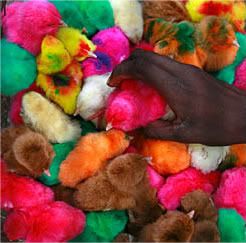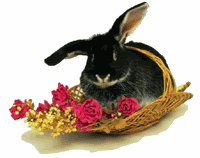One of the other popular trends around Easter time is the sale of colored chicks…and in some cases, Easter ducklings.
The tradition has even prompted an Easter Chick page at the Center for Disease Control and the International Bird Rescue Research Center (IBRRC) issued a press release on the environmental and health hazards posed by abandoned Easter ducklings.
Get the idea that these critters are a bad idea?
I am not sure just how long the tradition of dyeing Easter chicks or Easter ducklings has existed but I remember the agony of dead chicks from my childhood.
Nothing like traumatizing your child by giving them a pet that dies within a short time or exposing them to diseases such as salmonella.
Now it isn’t just Easter when surplus chicks are a problem for chicken farms–and do you blame them for taking advantage of an opportunity to profit on animals they would probably cull?
In my early days of exotic animal care and handling we often received the culls to feed to the reptiles, birds of prey, and mammals. (Whether you like it or not, whole foods are great for maintaining live animals.)
At that time the chicks would arrive in large plastic bags (dead via suffocation) and sometimes we would find one still alive.
I remember how warm the bags were from the body heat…
So yes, I think Easter chicks (or any other Easter live animal gift) is a bad idea.
If you are unaware at just how badly the animals produced for food (and Easter chicks) are treated…take a look at this chicken industry documentary website and some of the issues raised over poultry producers.
Did you know? Three in 10 Easter bunnies die and according to the Humane Society of Utah’s Easter Pet Statistics “…within the first few weeks of Easter an estimated 30% of all Easter “pets” die and another 60% to 70% are abandoned or turned in to shelters.'”
Most young chicks and ducklings won’t make it–but some do and I am sure you will be entertained by this amusing Easter chick story, Easter Chicks Gone Bad.
But funny stories aside, this is a dire time for many animals but on the upside, both house rabbits and chicken pets are now popular.
This means that there are resources for people to use when attempting to raise such critters–or save an Easter chick. These resources were not available twenty plus years ago.
Today you can get still buy chicks from some feed stores or pet stores. But in my area, people often are so put off by the sale of live animals that they go somewhere else to purchase their feed and pet food.
However it is possible to order chicks from a variety of companies that include poultry breeding farms, rare breed hatcheries, or small order poultry suppliers.
Chickens Pets: Ruffling Feathers or Going Green is something I discussed previously and getting informed or picking up tips before you get a chicken pet (or give one) are critical.
Anyway, there are variety of chicken breeds available to those who really want to get into it for the long term–and you can also visit Poultry U to check out other resources–but despite the resources that are available, Easter chicks are not a good idea.
The exception to this rule is the option is to give a flock of chicks through Heifer International–the group provides starter chicks so families can sustain their hungry families with eggs.
Why not substitute Easter Chicks plush alternatives instead of live chicks, ducklings, or bunnies?
And don’t forget to enjoy those Cadbury Eggs!



